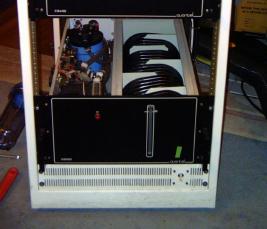
Or: fun with algae.
The laser is cooled by running tap water through a heat exchanger. The heat exchanger contains about 5 gallons of deionized water which is then pumped over the flash lamps and YAG rods.
Unfortunately, this laser had been neglected for some time. So the deionized water circuit was full of algae. What on earth was the algae eating? The deionizing filter had also filled up who knows how long ago and it fell apart when I removed it from the filter pot.
So the first thing I did was get a new deionizing filter. Unfortunately the original filter was a very odd size, it was half length. I suspect the previous owners were also unable to find replacements, the old one looked like it had been cut open and refilled with new resin pellets. So I got a new filter pot too. The new one is the standard 9 3/4 inch length, so it will be easy to replace. The new pot sticks out of the cooling unit, but the space above it in the rack is empty so I'm calling it not a problem.
I then replaced all the tubing, and rearranged where the filter pot was. The new location is on the supply side instead of the return side. That way I can close all the valves to the head and just run the water through the filter, to deionize it before running it through the head.
I also disassembled cleaned and reassembled the yag rod assemblies, but that is described elsewhere.
I then put in a particulate filter, filled the tank up with tap water, and ran it for a while. At the same time, I brushed all the surfaces I could reach with a tooth brush, knocking as much of the algae off as I could. I couldn't reach under the heat exchanger coil though.
I then swapped the particulate filter for the deionizing filter, filled the tank with 5 gallons of distilled water, and started pumping it through the deionizing filter.
To attempt to measure when the water was actually deionized, I built a little probe with two stainless steel electrodes a fixed distance apart, and attached it to my multi-meter set to measure resistance. Unfortunately, the readings made no sense. I suspect the multi-meter was running too much current through the probe, and causing a layer of oxide to form.
So after running the water through the filter for a few hours, I called it sufficiently deionized, and opened the valves to put it through the head. After much gurgling, all the air bubbles got out of the head, and even better, it didn't leak.
The head and all the umbilical tubing holds a surprising amount of water.